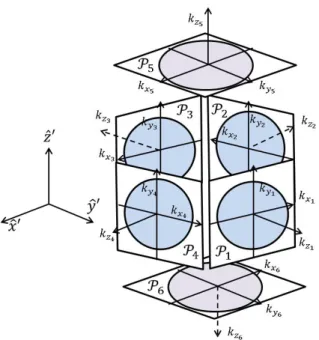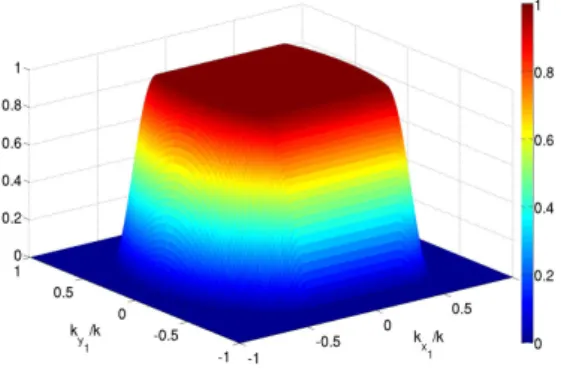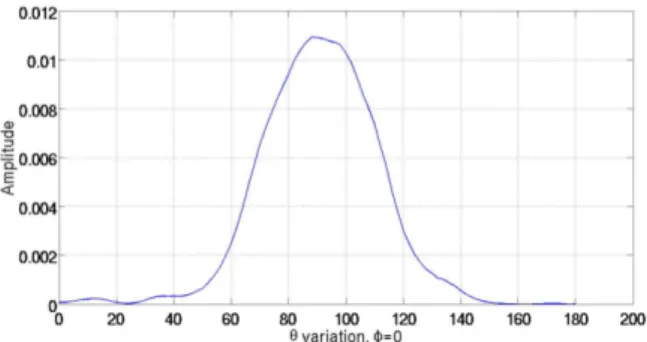HAL Id: hal-01262400
https://hal.archives-ouvertes.fr/hal-01262400
Submitted on 26 Jan 2016
HAL is a multi-disciplinary open access
archive for the deposit and dissemination of
sci-entific research documents, whether they are
pub-lished or not. The documents may come from
teaching and research institutions in France or
abroad, or from public or private research centers.
L’archive ouverte pluridisciplinaire HAL, est
destinée au dépôt et à la diffusion de documents
scientifiques de niveau recherche, publiés ou non,
émanant des établissements d’enseignement et de
recherche français ou étrangers, des laboratoires
publics ou privés.
Frame-based Gaussian beam shooting from experimental
far field data
Igor Francisco Arias Lopez, Christine Letrou
To cite this version:
Igor Francisco Arias Lopez, Christine Letrou. Frame-based Gaussian beam shooting from experimental
far field data. ICEAA 2014 : International Conference on Electromagnetics in Advanced Applications,
Aug 2014, Palm Beach, Aruba. pp.532 - 535, �10.1109/ICEAA.2014.6903914�. �hal-01262400�
Frame-based Gaussian beam shooting
from experimental far field data
I.F. Arias Lopez
∗C. Letrou
†Abstract — Frame decomposition is conventionally used to perform decomposition of fields radiated by large planar apertures into a half plane, in a rigor-ous and stable way. An algorithm based on a spec-tral partitioning concept has been developed to ex-tend frame-based Gaussian beam launching to om-nidirectional and non directive sources. Frame de-composition is applied in six planes in the spectral domain, starting from the knowledge of the radiated far field, which is partitioned through a “partition of unity” procedure. This communication outlines this method, then focuses on its application and test in a real life contextwhere initial far field data are ob-tained from measurements.
1 INTRODUCTION
Frame theory provides a rigorous framework to rep-resent source field distributions in the form of su-perpositions of translated and phase shifted Gaus-sian windows [1, 2]. These GausGaus-sian windows radi-ate fields in the form of paraxial Gaussian beams, in as much as their spectrum is sufficiently localized. Frame decomposition has thus been introduced as the initial discretization step in some Gaussian beam shooting (GBS) algorithms [3, 4]. It was also introduced to re-expand diffracted fields on planar obstacles or apertures, through a re-expansion al-gorithm performed in the course of Gaussian beam tracking in multi-reflecting environments [5].
Until recently, only planar source distributions were amenable to frame decomposition, and frame based GBS was better suited to highly directive radiating apertures than to less directive ones, due to inaccuraccies occuring in paraxial beam expressions for highly tilted beams.
In order to generalize frame-based Gaussian beam shooting to a wider range of source distri-butions and of antennas, with preserved accuracy and rigor, we have developed an algorithm based on a 3d spectral domain partition.
Given an antenna far field, its plane wave spec-trum (PWS) is known in any plane, hence in six planes, taken parallel to cube faces, radiating into
∗CENDIT Foundation, Direcci´on de Propagacion y
Ante-nas, Base Aerea Generalisimo Francisco de Miranda, Com-plejo Tecnologico Sim´on Rodriguez, Caracas,Venezuela, e-mail: igor arias2004@yahoo.com, tel.: +58 412 7065 773.
†T´el´ecom SudParis (Lab. SAMOVAR - UMR CNRS
5157), 9 rue Charles Fourier, 91011 Evry Cedex, France
six half-spaces. A partition of unity is then for-mulated which allows to synthetize the 3d far field from the summation of fields radiated by these six spectra, each multiplied by a partitioning window. Frame decomposition is then applied to these ”par-tial spectra”, in each of the six planes, enabling GBS from all the planes. Fields radiated by the six partial PWS are summed to obtain the 3d radiated fields.
Section 2 gives an outline of the “spectral par-titioning” formulation. Section 3 presents its ap-plication to experimental horn fields, the initial far field data being obtained from measurements.
2 FORMULATION
In this section, frame decomposition is first pre-sented as applied to functions of one variable, to introduce frame parameters and frame theory con-cepts, then to functions of two variables, in order to discretize field components of radiating planar dis-tributions. Finally, six decompositions in six differ-ent planes are combined in order to discretize fields radiated by any type of source.
Harmonic time dependence e−iωt, with ω the angular frequency, is assumed and suppressed in equations. The Fourier transform of a function g ∈ L2
(R), denotedeg, is defined as: e
g(kx) =
Z +∞
−∞
g(x)e−ikxxdx
2.1 Frame based Gaussian beam shooting In the L2
(R) Hilbert space, the set of Gaussian functions wmn(x) = w(x − m¯x)ein¯kx(x−m¯x), (m, n) ∈ Z2 with w(x) = s√ 2 L e −πx2 L2
is a frame if and only if ¯x¯kx = 2πν with ν < 1
(oversampling factor) [1]. ¯x and ¯kxare respectively
the spatial and spectral domain translation steps. Frames are complete sets hence any function f ∈ L2
(R) can be expressed as a weighted sum-mation of the frame windows:
f = X
(m,n)∈Z2
with the (non unique) amn complex coefficients
called “frame coefficients”. These coefficients can be calculated by projecting the function on a “dual frame” of functions [2, 4].
By Fourier transform of equation (1), the decom-position of ef on the frame obtained by translating the Gaussian windoww is easily obtained as:e
e f = X
(m,n)∈Z2
amneimn¯kx¯xwemn (2)
As is visible from equations (1) and (2), frame coefficients can be calculated either in the initial domain or in the transformed one.
Frames in L2
(R2) are defined as product frames:
wmnpq = wmnwpq, (m, n, p, q) ∈ Z4. If a
y-polarized field distribution radiating into the z > 0 half-space is decomposed on such a frame, with Amnpqthe frame coefficients, then the radiated field
at any point M with z > 0 is obtained as:
~
E(M ) = X
m,n,p,q
Amnpqei(mnlxκx+pqlyκy)B~mnpq(M )
where ~Bmnpqis the field radiated by the plane wave
spectrum (PWS) associated to the wmnpq frame
window used to discretize the Ey(x, y) function.
For spectrally narrow frame windows, the ~Bmnpq
radiated field can be expressed in the form of a Gaussian beam (ray type expression with complex curvature), based on a paraxial approximation in the spectral domain [3, 4].
2.2 Spectral partitioning
In this subsection, partial PWS are defined in six different planes, by multiplying the PWS of the an-tenna in each plane by a “partitioning function”. The partitioning functions are introduced to obtain the field at any observation point outside of the re-active region of the radiating source by summing up the fields calculated by GBS from several of these planes, based on frame decomposition of the partial PWS.
2.2.1 Notations
The far field radiated by the antenna is assumed to be known in all (θ, φ) directions in the global coor-dinate system (O, ˆx, ˆy, ˆz). Six coordinate systems Sj = (O, ˆxj, ˆyj, ˆzj), j = 1, . . . , 6, are introduced,
and plane wave spectra are defined in the six zj = 0
planes, called Pj = (O, ˆxj, ˆyj). Figure 1 gives an
exploded view of the Pj planes and of their
associ-ated spectral variables (kxj, kyj). The PWS of the
Figure 1: Pjplanes and associated spectral variables.
antenna in the Pj plane is denoted E~˜(j)(kxj, kyj)
and radiates into the zj> 0 half-space, noted Hj.
Any point M in the 3d space, except for the ori-gin O of all Pj planes, belongs to exactly three
dif-ferent Hj, j ∈ J half-spaces.
2.2.2 Partition of unity relation
The classical asymptotic expression of the radiated far field in a given half-space as a function of a PWS radiating into this half-space, makes it easy to deduce eachE~˜(j)PWS from the antenna far field in the Hj half-space.
Partial plane wave spectra (after partitioning) are defined in the Pj planes as:
~˜ Eχj(k
xj, kyj) =E~˜
(j)(k
xj, kyj) χj(kxj, kyj)
with χj(kxj, kyj), j = 1, ..., 6 partitioning functions.
In order to obtain the radiated far field of the antenna by summing up the fields radiated by all these partial PWS, the partitioning functions must verify [6]:
X
j∈J
χj(kxj, kyj) = 1
for any direction in the 3d space, defined by a wavevector ~k. J is the set of indices such that kzj > 0, and (kxj, kyj) are the components of ~k
2.2.3 Partition of unity functions
The two variable partitioning functions are ob-tained:
• as the product of two one-variable partitioning functions of variables (kxj and kyj), in planes
Pj, j = 1, . . . , 4 (“lateral” planes);
• as a one-variable partitioning function of krj =
q k2
xj + k
2
yj, in planes Pj, j ∈ {5, 6} (planes
oriented toward “bottom” and “top”).
With this choice, the χ5 and χ6 functions are
ro-tationally symmetric around the z0 axis. We also impose that χ1= χ3 and χ2= χ4.
The one-variable partitioning functions are de-rived from the Hann window, in order to minimze the widening effect in space of spectral truncation [7]. Figures 2 and 3 present the χ1 and χ5
func-tions, respectively.
Figure 2: Two-variable χ1 partitioning function.
Figure 3: Two-variable χ5 partitioning function.
3 NUMERICAL RESULTS
The algorithm presented in the previous section has been validated in the case of analytically
defined omnidirectional radiation patterns (half-wavelength dipole, dipole array). The far field of such antennas is synthetized by GBS from 6 planes where spectral partitioning has been applied to the initially known antenna PWS [6].
In real life contexts, antennas are generally known by their far field radiation patterns, and more accurate simulations (of propagation for in-stance) are obtained if measured antenna patterns are used to characterize the antenna radiation, in-stead of closed form theoretical expressions. We have applied the frame based GBS algorithm in-cluding spectral partitioning to the measured far field of a horn.
Frame coefficient computation involves a discrete Fourier transform in the spectral domain, and the required data points are on a regular grid in each of the six planes used for GBS, but by no means on a regular grid on a sphere centered on the antenna. For this reason, the measured far field data need to be interpolated in the course of frame coefficient calculation.
Figure 4: Corrugated horn (cut).
The measured horn is a corrugated horn shown in Figure 4. Its aperture diameter is 24 centime-ters, and it was tested at 6 GHz on a sphere of radius 5 meters, in the far field of the antenna, with a 2 degree step along φ and θ. A rectangu-lar horn is used as testing antenna. Co- and cross-polarizations (linear ones) patterns were measured. Figures 5 and 6 present the measured and syn-thetized far field of this horn, which compare well. Figures 7 and 8 present a comparison of 1d pat-terns, for one cartesian component in the far field. Except for inaccuracies in measured data (align-ment), the two patterns compare very well again.
Figure 5: Horn measured far field magnitude.
Figure 6: Horn far field magnitude synthetized by GBS.
4 CONCLUSION
The “spectral partitioning” algorithm has been shown to efficiently complement the usual frame-based Gaussian beam shooting method, in the case of non directive antenna fields. The method has been applied to experimentally known patterns (discretized measured data). The accuracy of the fields computed by GBS is assessed by comparison with the initial measured data in the far field. Re-sults assessing the ability of the method to perform far to “near” (intermediate zone) field transforma-tion will be presented at the conference.
Figure 7: Horn measured far field component.
Figure 8: Horn far field component synthetized by GBS.
References
[1] D. Lugara and C. Letrou, “Alternative to Ga-bor’s representation of plane aperture radia-tion,” Electron. Lett., vol. 34, no. 24, pp. 2286– 2287, Nov. 1998.
[2] ——, “Printed antennas analysis by a Gabor frame-based method of moments,” IEEE Trans. Antennas Propagat., vol. 50, no. 11, pp. 1588– 1597, 2002.
[3] D. Lugara, C. Letrou, A. Shlivinski, E. Heyman, and A. Boag, “Frame-based Gaussian beam summation method: Theory and application,” Radio Science, vol. 38, no. 2, Apr. 2003.
[4] A. Shlivinski, E. Heyman, A. Boag, and C. Letrou, “A phase-space beam summa-tion formulasumma-tion for ultrawide-band radiasumma-tion,” IEEE Trans. Antennas Propagat., vol. 52, no. 8, pp. 2042–2056, 2004.
[5] I. Ghannoum, C. Letrou, and G. Beauquet, “Frame based Gaussian beam bouncing,” in EMTS’10 : 20th International Symposium on Electromagnetic Theory, IEEE, Ed., 2010, pp. 68 – 71.
[6] I. A. Lopez and C. Letrou, “Gaussian beam launching based on frame decomposition and 3d spectral partition,” in ICEAA ’13 : Int. Conf. on Electromagnetics in Advanced Applications, Torino, Italy, Sept. 2013, pp. 692 – 695.
[7] ——, “Frame decomposition of scattered fields,” in ICEAA ’11 : Int. Conf. on Elec-tromagnetics in Advanced Applications, Torino, Italy, Sept. 2011, pp. 1261 – 1264.


